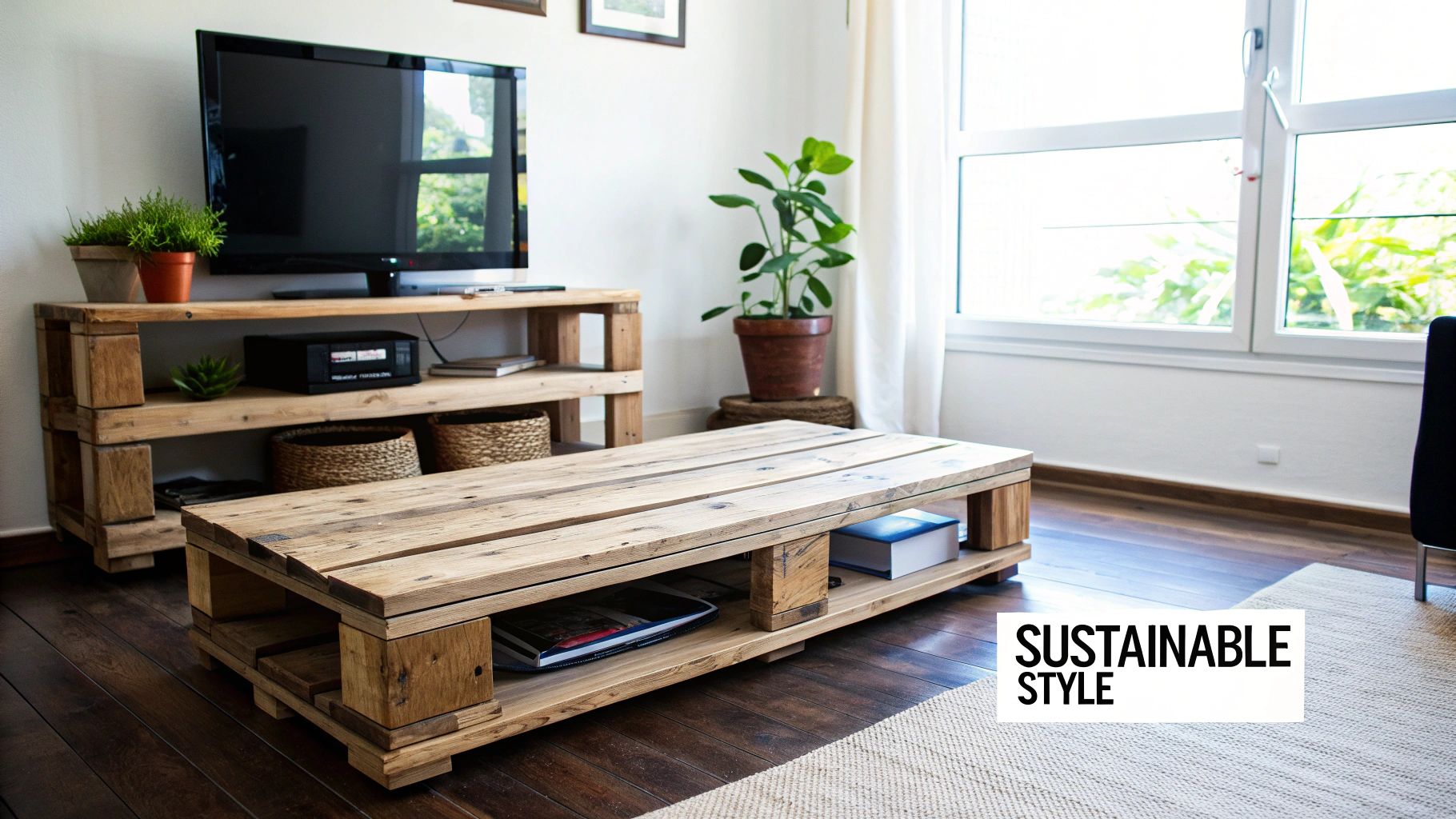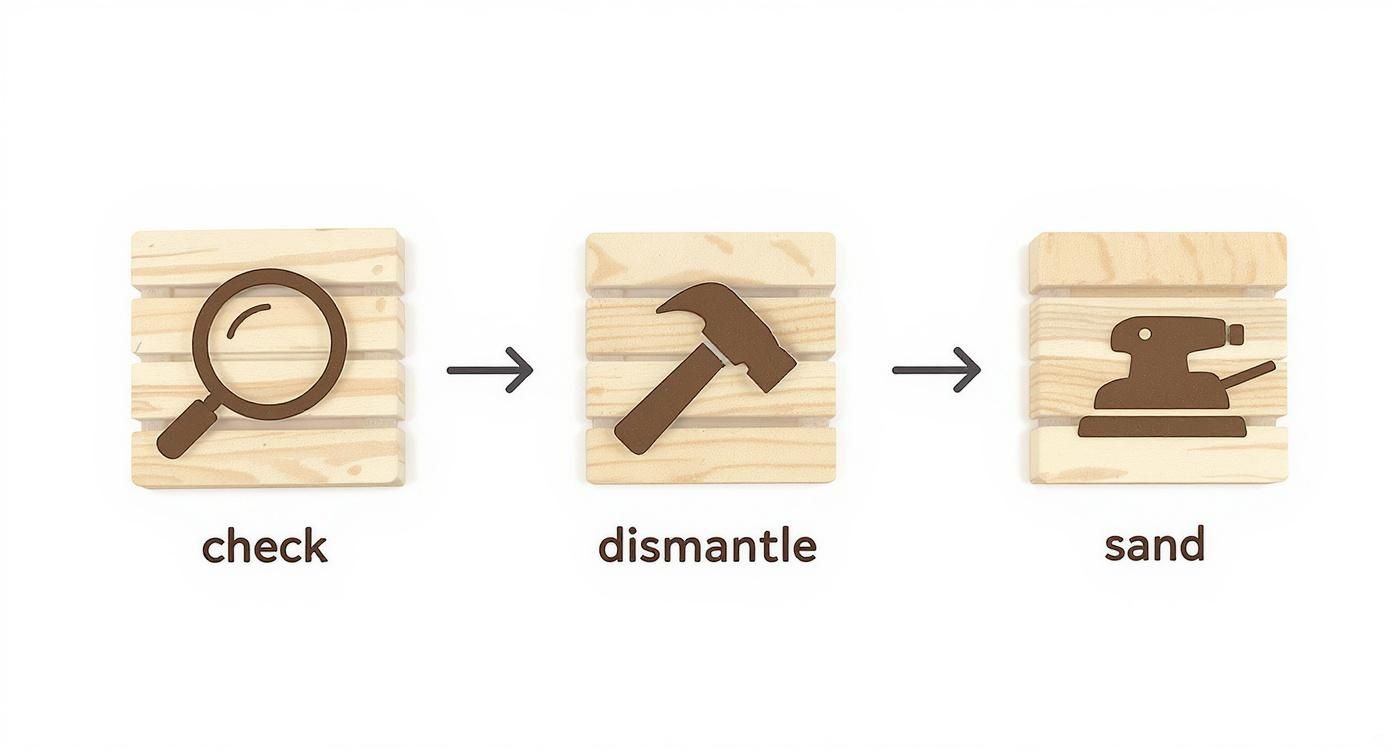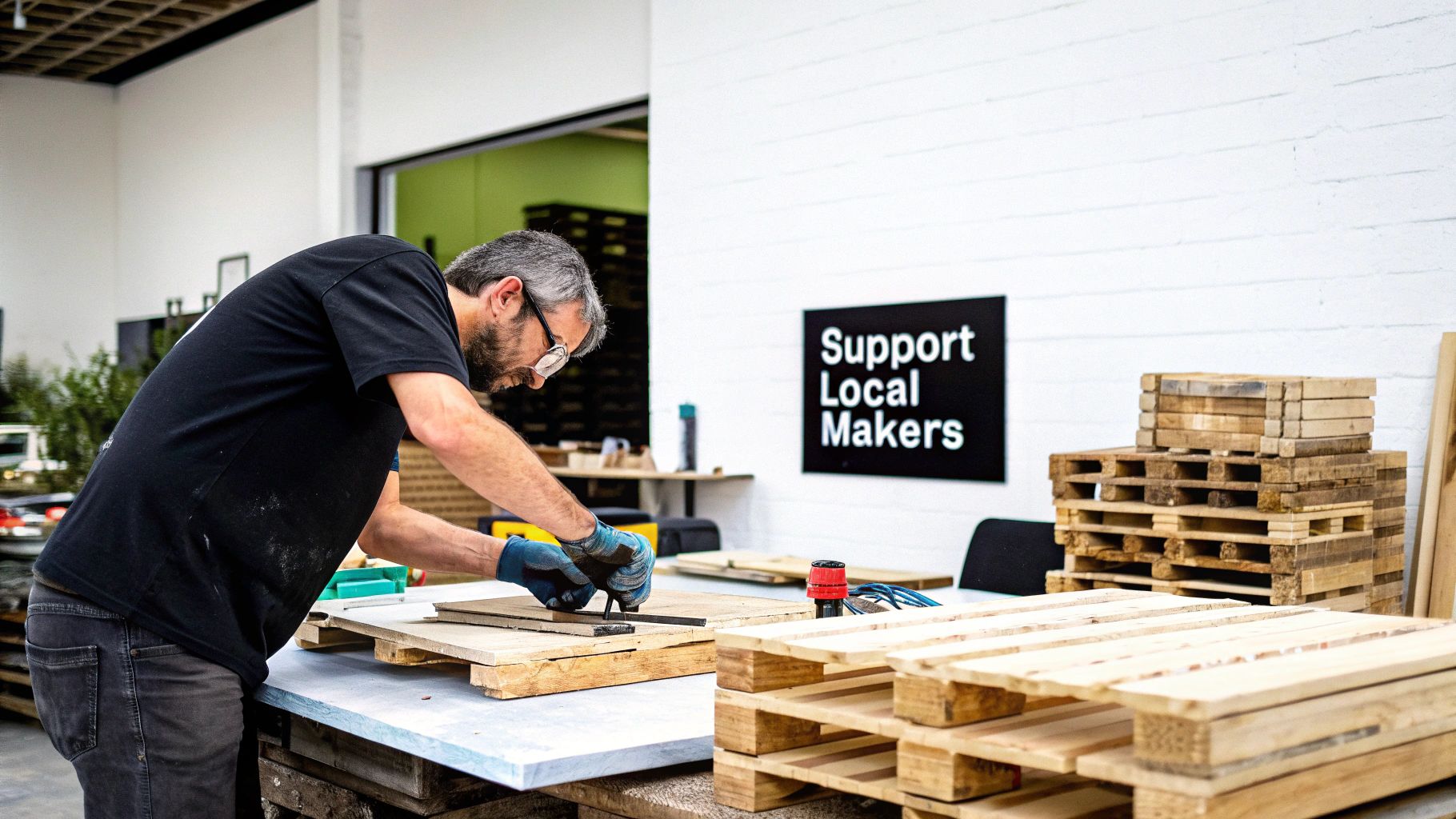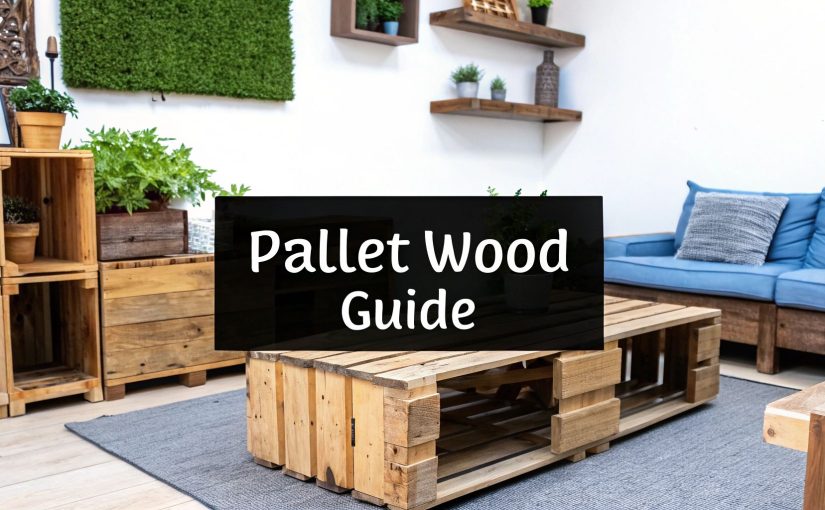Ever wondered what happens to those simple wooden platforms used for shipping goods? Well, they’re getting a second chance at life, and a very stylish one at that. Pallet wood furniture is all about taking these discarded shipping pallets and upcycling them into beautiful, functional pieces for your home and events.
It’s a brilliant move towards decor that’s sustainable, affordable, and totally personalised. We’re talking about turning what was once industrial waste into unique, conversation-starting items.
The Rise of Pallet Wood Furniture

What used to be seen as nothing more than shipping material has found a celebrated new beginning in homes all across South Africa. The buzz around pallet wood furniture isn’t just some passing trend; it’s a full-blown movement. It’s driven by a love for rustic charm, a need for practical solutions, and a growing desire to be more environmentally conscious.
When you transform a humble pallet into a coffee table, a garden planter, or even a chic bed frame, you’re doing more than just decorating. You’re making a statement. It’s about choosing resourcefulness over mass production and celebrating your own unique style. This approach lets you create spaces that are truly you, without the hefty price tag that usually comes with custom furniture.
More Than Just a Style Choice
The magic of pallet wood furniture goes way beyond its rugged good looks. It taps into a bigger shift towards smarter consumerism, where the story behind an item is just as important as how it looks. Every piece of reclaimed pallet wood has a history—unique grains, little nicks, and markings that add character a factory-made piece could never replicate.
Embracing pallet wood furniture isn’t just about saving a few rands. It’s about taking part in the circular economy, cutting down on landfill waste and giving a new purpose to materials that would otherwise be thrown away.
At the end of the day, choosing or creating pallet wood furniture lines up with some of today’s most important values:
- Sustainability: It gives a second life to industrial leftovers, keeping them out of our landfills.
- Affordability: The raw material costs next to nothing, making it an accessible way to get beautiful, sturdy furniture.
- Creative Expression: The DIY possibilities are endless, giving you complete freedom to customise your decor and let your personality shine.
Why Sustainable Decor Is Booming in South Africa
The appeal of pallet wood furniture runs much deeper than just its rustic good looks. It taps directly into a powerful and growing movement towards greener living right here in South Africa. We’re all becoming more conscious consumers, looking for home goods that do more than just fill a space – they need to reflect our commitment to the environment and to genuine, honest craftsmanship. This isn’t just about styling a home; it’s about making a real difference.
Choosing sustainable decor like pallet wood furniture is a brilliant, hands-on way to get involved in the circular economy. Instead of adding to our already strained landfills, this simple choice gives industrial materials a second, much more beautiful life. It’s a smart act of resourcefulness that cuts down on waste, reduces the demand for new raw materials, and ultimately supports a healthier cycle of consumption. This is the mindset that’s really starting to shake up the local decor scene.
A Conscious Consumer Choice
This shift is also being driven by a desire for authenticity and a passion for supporting local talent. Upcycled furniture is the territory of small-scale artisans and creative entrepreneurs who work magic, turning reclaimed materials into one-of-a-kind, handcrafted pieces. When you choose pallet furniture, you’re not just decorating your home; you’re investing in your local community and helping a culture of creativity thrive.
The growing taste for eco-friendly materials is making some serious economic waves, too. South Africa’s furniture market is valued at roughly $2.47 billion USD and is set to grow steadily, thanks in large part to urbanisation and this exact demand for sustainable options. It just goes to show that pallet wood furniture is a key player in a much larger, economically important move towards greener living. You can discover more insights about the South African furniture market and its future growth.
Choosing pallet furniture is a statement. It says you value sustainability, appreciate the story behind your decor, and believe in the power of creative reuse to build a better future.
At the end of the day, this boom in sustainable decor is about so much more than just furniture. It represents a collective step towards a more mindful and responsible way of living, where style and substance go hand in hand. Every piece of pallet wood furniture in a home is a small but meaningful victory for a greener planet.
How to Source and Prepare Pallet Wood Safely
Turning a rough industrial pallet into a piece of gorgeous furniture is a rewarding process, but it all starts with picking the right wood and prepping it properly. You see, not all pallets are created equal, and your safety has to come first. The real secret is learning to read the markings stamped onto the wood—these little codes tell you the pallet’s life story.
Think of the stamps as a passport for the wood. The one visa you’re looking for is the “HT” stamp. This little mark means the pallet was heat-treated to get rid of any pests, making it perfectly safe to bring into your home or use at your event. It’s the green light you need to get your creative project started.
On the flip side, if you spot a pallet marked with “MB”, walk away. This means it was treated with Methyl Bromide, a nasty, toxic fumigant you definitely don’t want anywhere near your furniture. It’s also smart to steer clear of pallets with big, mystery stains, spills, or weird smells. They could have been used to haul hazardous chemicals, and it’s just not worth the risk.
Before you start building, you need to know what you’re working with. Use this quick reference guide to check the pallet stamps and see if the wood is safe for your next masterpiece.
Pallet Markings You Need to Know
| Pallet Stamp | What It Means | Is It Safe for Furniture? |
|---|---|---|
| HT | Heat-Treated: Wood was heated to a minimum of 56°C for 30 minutes. | Yes. This is the safest option, as no chemicals were used. |
| MB | Methyl Bromide: Fumigated with a highly toxic pesticide. | No. Avoid this wood at all costs. It’s not safe for handling. |
| DB | Debarked: The outer layer of bark was removed. | Yes. This doesn’t affect safety and just describes the wood’s state. |
| KD | Kiln-Dried: Dried in a kiln to reduce moisture content. | Yes. Often paired with HT, this is a great, stable wood to work with. |
| No Stamp | Unmarked or unclear markings. | Use with caution. If you can’t identify its origin, it’s best to leave it. |
Always look for that HT stamp! It’s your best guarantee that you’re starting with safe, clean materials for your furniture.
Finding and Dismantling Your Pallets
You’d be surprised how easy it is to find good, safe pallets. Many local hardware stores, garden centres, and even grocery shops are often more than happy to give away their unwanted heat-treated pallets. Just have a friendly chat with the store manager—you might just walk away with a treasure trove of free materials.
Once you’ve got your HT-stamped pallet, the next challenge is taking it apart without splitting the very planks you want to use. You’ll need a pry bar, a hammer, and a bit of elbow grease. Work slowly, easing the boards away from the support blocks to keep as much of that lovely wood intact as possible.
The Final Preparation Steps
With your pallet now in pieces, it’s time to transform those rough planks into a smooth, clean canvas ready for whatever you have planned.
- Clean and Sanitise: First things first, give every board a good scrub with a stiff brush, warm water, and a bit of mild detergent. For a deeper clean, a mix of water and vinegar works wonders to sanitise the wood. Let everything dry completely in the sun.
- Remove Nails: Go over each piece carefully and pull out any leftover nails or staples. This is a crucial safety step before you even think about sanding.
- Sand to a Smooth Finish: This is where the magic happens. Sanding is what gives your project that polished, professional look. Start with a coarse sandpaper (around 80-grit) to knock down the splinters and rough spots. Then, move to a medium-grit (120-grit) and finish with a fine-grit (220-grit) for a surface that’s silky smooth to the touch.
For more inspiration on finishing touches, you can get great ideas on styling wooden tables and chairs in our detailed guide.
After these steps, your reclaimed wood is officially prepped and ready for assembly, staining, or painting. Now the real fun begins
Creative Pallet Furniture Ideas for Your Space
The real magic of pallet wood furniture is just how much you can do with it. Once you’ve got your hands on some wood and cleaned it up, a whole world of creativity opens up. You can craft one-of-a-kind pieces for any corner of your home or event space, and the journey from a rough shipping plank to a stylish feature is simpler than you’d imagine.
A simple weekend project is the perfect way to get started. Picture a rustic coffee table bringing a bit of warmth to your living room, or some chic wall shelves offering a clean, minimalist storage spot. For your outdoor area, a vertical garden planter made from just one pallet can breathe life into a small balcony or patio, creating an amazing green feature wall with very little fuss.
From Simple Builds to Ambitious Designs
As you get more comfortable working with the wood, the scale of your projects can grow too. Pallet wood is more than strong enough for bigger, more ambitious creations that really make a statement.
- Outdoor Lounge Sets: Why not build your own sofas and benches? You’ll have a durable, comfy, and seriously budget-friendly patio setup, perfect for those long South African summers.
- Sturdy Bed Frames: You could create a stunning bohemian or industrial-style bed frame, complete with handy built-in storage nooks underneath.
- Functional Kitchen Islands: Build a custom kitchen island on wheels for extra counter space and a touch of rustic charm that fits right into your kitchen.
The infographic below gives you a clear idea of the simple process for getting your raw material ready.

This handy visual guide breaks down the main prep stages—checking, dismantling, and sanding—into easy-to-follow steps. What’s great is that each idea can be adapted to suit a different decor style. An unstained pallet coffee table, for example, is a perfect fit for a coastal or industrial theme, while a brightly painted vertical garden looks right at home in a bohemian space.
For event styling, a beautifully finished pallet cocktail table can be a real centrepiece. You can see some stunning examples in our dedicated post on the rustic cocktail table.
The key is to look past the raw wood and see its potential. Every single plank holds the promise of becoming something both beautiful and functional, adding a touch of personalised character that you just don’t get with mass-produced furniture.
Pallet Furniture and the Local Economy

When you choose pallet wood furniture, you’re doing more than just picking out a cool piece for your home or event. You’re actually sending positive ripples right through the local economy.
This sustainable trend has become a real force for good, directly propping up South African artisans and small businesses. It allows entrepreneurs to turn what was once industrial waste into something beautiful and functional, all while building a livelihood with very little start-up capital.
This clever reuse breathes new life into materials that would otherwise clog up our landfills, which fits perfectly with national efforts to reduce waste. It’s sparked a vibrant micro-economy where local makers can really shine, giving us unique, handcrafted alternatives to all the mass-produced stuff out there. Your purchase becomes a direct investment in local skills and real craftsmanship.
Fuelling Economic Growth
The impact is probably bigger than you think. South Africa’s combined forestry, timber, and furniture sectors contribute a massive 57.7 billion ZAR to our national GDP. Within that huge industry, pallet wood furniture is a growing niche that champions waste recovery and gives a real boost to the circular economy. If you want to dive deeper, you can explore the full report on forestry-based industries.
This link between sustainability and economic health is so important. When you opt for upcycled pieces, you’re not just buying a table or a chair; you’re backing a greener, more prosperous future for the country.
Opting for pallet wood furniture is a conscious choice to back local artisans, reduce environmental impact, and celebrate the resourcefulness that defines South African creativity.
This approach also opens up some fantastic new options for event styling. Event organisers can create stunning, rustic atmospheres while championing local suppliers at the same time. If you’re busy planning an event, think about the unique appeal of furniture for hire in Cape Town to make a statement that’s both sustainable and seriously stylish.
Each piece tells a story of local ingenuity, making your furniture more than just functional—it becomes a conversation starter with a positive community impact.
Common Questions About Pallet Wood Furniture
Thinking about starting your own project or choosing a piece for your home? It’s completely normal to have a few questions swirling around. Getting to grips with the ins and outs of pallet wood furniture is the key to making a choice you’ll love for years to come. Let’s clear up some of the most common queries.
The journey from a simple shipping pallet to a beautiful piece of furniture involves a few crucial steps. Knowing the answers will give you the confidence to dive in, whether you’re building it yourself or buying from a local artisan.
Is It Safe to Use Any Pallet for Indoor Furniture?
Absolutely not. This is probably the most critical safety point to remember. Not all pallets are created equal, and some are a definite no-go for indoor use.
The only type you should ever consider for pallet wood furniture is one marked with an “HT” stamp. This simple code means it was heat-treated to get rid of pests, not fumigated with nasty chemicals. On the flip side, you must avoid any pallet stamped with “MB,” which stands for Methyl Bromide. This is a toxic fumigant that has no place in your home.
It’s also smart to reject any pallet with visible stains, chemical spills, or strange smells—it could have been used to haul hazardous materials. Always try to get your pallets from reliable spots like grocery or hardware stores that can give you a bit of history on them.
Your safety always comes first. Double-check for that ‘HT’ stamp before you even think about bringing pallet wood into your home. It’s a non-negotiable step that ensures your furniture is free from harmful chemicals.
How Can I Protect My Outdoor Pallet Furniture?
To keep your outdoor pallet furniture looking great and lasting through the seasons, a good seal is non-negotiable. The wood is naturally porous, so protecting it from moisture and the harsh South African sun is the secret to its longevity.
After you’ve sanded the wood down until it’s completely smooth, your next step is to apply a protective finish.
- Choose the Right Sealant: Go for a high-quality outdoor wood sealant, varnish, or deck stain that offers both water resistance and UV protection.
- Apply Thorough Coats: You’ll want to apply at least two to three generous coats. Pay extra attention to the cut ends of the planks, as this is where moisture loves to sneak in.
- Plan for Maintenance: Depending on your local climate, plan to reapply a fresh coat every one to two years. Using waterproof covers during rainy seasons will also dramatically extend the life of your furniture.
What Is the Secret to a Really Smooth Finish?
Getting that beautifully smooth, professional finish is all about progressive sanding. It’s a bit of a process that takes the wood from rough and splintery to silky smooth, but trust me, it’s worth the effort for the final result. Don’t be tempted to skip a step!
The technique is simple: start with a coarse grit and gradually move to finer ones.
- Start Coarse: Begin with a coarse-grit sandpaper (around 60-80 grit). This first pass will power through the rough surface, knock down splinters, and erase any printed markings. An orbital sander will make this stage much faster.
- Move to Medium: Next, switch to a medium-grit paper (like 120 grit). This step smooths out the rough marks left by the first round of sanding and really starts to refine the surface.
- Finish Fine: For that final polish, use a fine-grit sandpaper (220 grit or higher). This will give the wood that polished feel that’s perfect for staining or painting.
A pro tip: remember to wipe the wood down with a tack cloth between each sanding stage to get rid of all the dust. This ensures your final finish is absolutely flawless.
Ready to bring the rustic charm and sustainable style of pallet wood furniture to your next event without the DIY hassle? ABC Hire offers a stunning collection of event furniture for hire in Cape Town and surrounding areas. Explore our range and get a quote today

